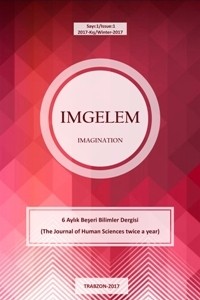2015 MÜLTECİ KRİZİNDE SLOVEN ULUSAL KİMLİĞİNDEKİ “ÖTEKİ”NİN DÖNÜŞMESİ
2015 Avrupa mülteci krizinin ertesinde, bir dizi akademik çalışma Doğu Avrupa’daki devletlerin mülteci akışına yönelik politikalarını açıklarken popülist liderliklere odaklanmıştır. Bu makalede ilgili çalışmalardan farklı olarak, Sloven toplumunda mülteci akışına yönelik toplumsal tepkiyi anlamak için milli olmayan unsurların, milli sınırlar içine girmesiyle bozulan vatan algısı çalışılmaktadır. Bu amaçla, çalışmada Sloven entelijensiyanın, Sloven milli kimliğini inşa etme politikası ve Yugoslavya’dan kopma sürecinde stereotipik hale getirilen Balkan ‘Öteki’si incelenmektedir. Mülteci krizi sırasında münhasır Sloven milli vatanına yönelik postkomünist Sloven toplumunun bozulan algılarını açıklamak için milliyetçilik çalışmalarındaki modernist teorilerden ve kimlikliklerin akışkanlığının anlaşılmasına yardımcı olan postmodern yaklaşımlardan faydalanılmaktadır. Makale Yugoslavya’dan ayrılma sürecinde avrupalılaşma ve küreselleşme etkisi altında inşa edilen Sloven ulusal kimliğinin, 2015 mülteci krizi sırasında ve sonrasında yeniden kurulduğu ve Sloven kimliğinin Öteki’sinin Balkan’dan Ortadoğu ve İslam’a dönüştüğü savunulmakta ve bu argüman şu konular üzerinden incelenmektedir: a) Sloven yurttaşların değişen algıları, b) Slovenya’nın yeni sığınma yasası, c) Slovenya’nın Balkan devletleriyle iş birliği ve d) önde gelen Slovenlerin söylemleri ve sosyal medya gruplarındaki paylaşımlar.
Anahtar Kelimeler:
mülteci krizi, milli mekân, muhayyel cemaatler, ulusçuluk, Öteki
MOBILIZATION OF THE “OTHER” IN SLOVENE NATIONAL IDENTITY DURING THE 2015 REFUGEE CRISIS
In the aftermath of the 2015 European refugee crisis, a wave of scholarship has considered Eastern European populist leaderships to explain these states’ policies toward refugee influx. This article challenges these accounts by contending that relationship between influx of foreign nationals in the name of migrants into a national homeland and deteriorating national perceptions deserves greater attention to understand social strife within Slovene society against the flow. To this end, it examines Slovene intelligentsia’s policy of construction of Slovene national identity and its stereotyping Balkan ‘Other’ during the breaking up of Yugoslavia. Concretely, it applies postmodern approach that identities are fluid and benefiting from modernist theories on nationalism to explain deteriorated perceptions of post-communist Slovene society toward distinct Slovene national homeland in the time of refugee influx. The article finds that Slovene national identity that was constructed during the secession from Yugoslavia under the influences of europeanization and globalization has been re-constructed during and aftermath of the 2015 refugee crisis and the Other of Slovene identity mobilized or changed from the Balkan to the Middle East and Islam and that can be investigated through developments, a) changing perceptions of the Slovene nationals, b) Slovenia’s new asylum law, c) collaboration of Slovenia and the Balkan states d) discourses of prominent Slovenes and social media groups.
Keywords:
refugee crisis, national space, imagined communities, nationalism, Other,
___
- Amnesty International. (2016, March 4). Slovenia: New Asylum Legislation Would Violate the Rights of Refugees and Asylum Seekers.
- Anderson, B. (1991). Imagined Communities: Reflections on the Origin and the Spread of Nationalism, London: Verso.
- Bajt, V. (2005). Contemporary Slovenia and the “Other”, M. Pajnik and T. Kuz (Ed.), In Nation-States and Xenophobias: In the Ruins of Former Yugoslavia (43-60), Manic, Mirovni Institut.
- Yayın Aralığı: Yılda 2 Sayı
- Başlangıç: 2017
- Yayıncı: Musa Yavuz ALPTEKİN
Sayıdaki Diğer Makaleler
MULTIMODAL TARTIŞMA: İKİ SİYASİ REKLAM GÖRSELİ ÜZERİNE BİR ANALİZ
Fatma Nazlı KÖKSAL, Hanife ERİŞEN
TÜRK SİYASİ HAYATININ KURUMSALCI YAKLAŞIMLAR AÇISINDAN İNCELENMESİ
Melike SEMERCİ, İlker AKTÜRK, Ömer Miraç YAMAN
2015 MÜLTECİ KRİZİNDE SLOVEN ULUSAL KİMLİĞİNDEKİ “ÖTEKİ”NİN DÖNÜŞMESİ
COVİD-19 PANDEMİSİNİN E-TİCARET ÜZERİNDEKİ ETKİSİNİN İNCELENMESİ
ÇİN’İN AFRİKA AÇILIMI VE AFRİKA KITASININ ÇİN İÇİN STRATEJİK ÖNEMİ
